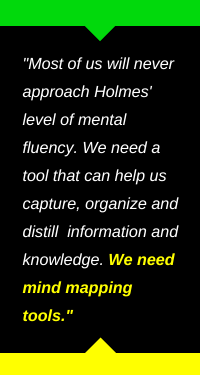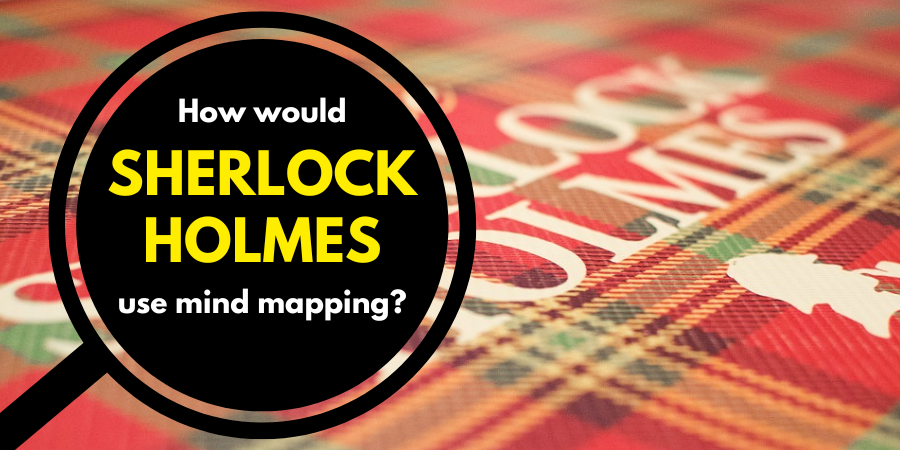If Sherlock Holmes was alive today, how would he use mind mapping to solve crimes?
 Sherlock Holmes, the legendary crime investigator and central character of Sir Arthur Conan Doyle’s popular novels, was known for his extraordinary skills of observation, forensic science and logical reasoning that was far beyond the abilities of the average person. He relied on his prodigious brain, which he called “my mind attic,” to capture and arrange an astounding body of knowledge on key topics of interest to him.
Sherlock Holmes, the legendary crime investigator and central character of Sir Arthur Conan Doyle’s popular novels, was known for his extraordinary skills of observation, forensic science and logical reasoning that was far beyond the abilities of the average person. He relied on his prodigious brain, which he called “my mind attic,” to capture and arrange an astounding body of knowledge on key topics of interest to him.
Most of us will never approach Holmes’ level of mental fluency. We need a tool that can help us capture, organize and distill information and knowledge, and draw inferences, connections and conclusions from it.
We need mind mapping tools.
“Elementary” ways Holmes would use mind mapping
That begs the question: How WOULD the legendary investigator use mind mapping tools to help him solve crimes? Here are some ideas:
- He would use symbols or icons to classify evidenced by type
- He would attach photographs to branches to document evidence from the scene of the crime
- He would enter extended notes into topic notes, which would keep them close at hand but not clutter his thinking
- He might use a right-facing map format to create a timeline of events leading up to and after the crime
- He would use relationship lines to connect related pieces of information and evidence
- He would store contact information for each of the people he interviewed as part of his investigation within the mind map, making it easy to retrieve at a moment’s notice
- He would add links to relevant news stories about the crime to his mind map
- If Holmes used a web-based mind mapping application, he could delegate research to his assistant and partner, Dr. Watson, who could contribute his findings to it
- He could conduct keyword searches of archived cases, which would help him uncover similarities and patterns from past cases
- He could attach forensic lab reports to his mind map, with important findings from them summarized in text notes
- Research often creates more questions and information needs than it answers. Holmes could maintain a list of tasks within his mind map, summarizing leads he needed to follow up, tests he needed to conduct and witnesses and subject matter experts he needed to interview. This would help him stay organized and focused on the case. For someone like Holmes, who had a myriad of passionate interests and was easily distracted, this could be very powerful.
As you can see, a modern tool like a mind map would open up a world of possibilities to this 19th century crime fighter. I wouldn’t hesitate to say that it would have revolutionized his work!
How can you use this approach in your work?
 Obviously, you are not a fictional crime fighter living in the 19th century. You’re a knowledge worker or executive trying to manage your workload and innovate in the 21st century. What can you take away from our little thinking exercise? Here is some food for thought:
Obviously, you are not a fictional crime fighter living in the 19th century. You’re a knowledge worker or executive trying to manage your workload and innovate in the 21st century. What can you take away from our little thinking exercise? Here is some food for thought:
- Mind mapping software is an excellent tool for capturing a variety of research and knowledge, and to arrange it in ways that make the most sense to you.
- Filtering and keyword searching can be powerful tools to reveal patterns and connections that would otherwise be hidden in the information you’ve gathered.
- Using a web-based mind mapping application enables you to delegate parts of the project to others. They can conduct research on your behalf, and add their findings to it. You can also give others the right to review your shared map, comment on it and suggest other sources of information and inferences that you may have missed. This can be powerful!
- Topic enhancements, such as notes, links and attachments, enable you to create a collection of deep knowledge about a topic or project. What’s even more significant is that they do so without adding visual clutter to your mind map – yet they are always just a single mouse click away. That’s also powerful!
- Coloring topics and adding icons or symbols to them enables you to visually classify information by type. That can help you make sense of all of the information you’ve gathered. Some programs even enable you to filter map contents based on the icon or symbol they contain!
- Don’t forget that you can use your mind map to do simple task and project management. Use it to keep track of missing information you still need, colleagues you need to contact and the issues you need to discuss with them, and so forth.


Leave a Reply